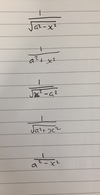Geometry & Motion Flashcards
(78 cards)
Define a vector function

What is the parameterisation of a circle with centre (0,0) and radius R
r(t) = (Rcost, Rsint)
What is the parameterisation of a circle with centre (a,b) and radius R
r(t) = (a + Rcost, b + Rsint)
What is the parameterisation of a parabola
r(t) = (t,at2)
What is the parameterisation of the top half of a hyperbola
r(t) = (bsinht, acosht)
When is a curve closed
if I = [a,b] then r(a) = r(b)
When is a curve embedded
If it doesnt intersect
What is the general equation for an ellipse?
(x/a)2 + (y/b)2 = 1
What is the general equation for a hyperbola
(x/a)2 - (y/b)2 = 1
Find a parameterisation of the curve traced by a marked point on the perimeter of a unit circle that is rolling counter clockwise and without slippage around a fixed unit circle centred at the origin

What is the length of the curve l(c) denoted as

When is a parameterisation a natural parameterisation (or arc-length)
When the absolute value of the derivative is 1
Let r(t) be a parameterisation of a curve C in R3 such that r(0) = (R,-R,R). Suppose r(t) doesnt equal zero and r(t) . r’(t) = 0 for all points of C. Show that any such C must lie on the surface of a sphere. Find the position of the sphere’s centre and determine its radius

In two dimensions, mark a point on the outer rim of a wheel of radius R0 rolling on the horizonal line y=0 without slippage. Assume the centre of the wheel is moving with velocity v=V0i and that the marked point is (0,0) at time t=0.
i) Find r(t)
ii) compute the path between two consecutive points where the path touches y=0

How would you compute the length of the segment of the cardioid (r, theta) = (2 - 2cost, t)
Convert to cartesian, then l(c) = integral of the absolute value of the derivative


Give the standard integral results of these functions


Give the equation for the unit tangent vector
T = r’ / ||r’||
Give the equation for the principal normal vector
N = T’ / ||T’||
What is the equation for curvature, and the radius of curvature?
k = ||dT/ds||, p=1/k
What is the equation for curvature in terms of T and r
k = ||T’|| / ||r’||
What is the equation for curvature containing r and its derivatives?
k = ||r’(t) x r’‘(t)|| / ||r’(t)||3
Give the two Frenet-Serret equations
T’(s) = k(s)N(s)
N’(s) = -k(s)T’(s)
Define the Binormal Vector
B = T x N


















































